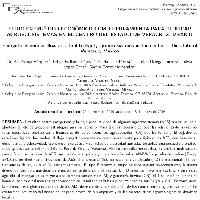Resumen
-
Los altos costos energéticos y la baja productividad de algunos agroecosistemas (AES) a nivel mundial plantean el reto de proponer estrategias para su rediseño. Para ello, es necesario conocer las relaciones de las estructuras operativas, productivas y financieras de los componentes agropecuarios (CA) que los forman. El objetivo de esta investigación fue evaluar el flujo energético-económico como herramienta para tipificar los AES, con base en su eficiencia de productividad, económica, energética y su índice de diversidad agrícola. Se aplicó una encuesta a productores agropecuarios del municipio de Paso de Ovejas, Veracruz, México, se realizaron técnicas de análisis multivariado para diferenciar los tipos de AES: agrupación jerárquica aglomerativa y k-media, ANAVAR y prueba de medias (Tukey; p<0.05). Se identificaron tres tipos de AES: el empresarial (E), transicional diversificado (TD) y tradicional (T), con frecuencias de 37, 17 y 46 %, respectivamente. El tipo E mostró el mejor balance energético-económico y la menor diversidad, debido a que depende principalmente de la caña de azúcar. El TD presentó mayor ingreso total y diversidad agrícola, al manejar en su mayoría una combinación de maíz (M) y ganadería bovina (GB). El T se ubicó en la zona de lomerío, con bajo balance energético-económico, resultado de la baja productividad de sus CA (M y GB). En conclusión, la eficiencia energética-económica de los AES depende de la combinación de los componentes agropecuarios que los conforman, resultado del diseño de los productores, de sus objetivos y de las características agroecológicas de donde se localizan.
-
The high energetic costs and the low productivity of some agroecosystems (AES) at a global level pose the challenge of suggesting strategies for its redesign. To this end, it is necessary to know the relations between the operative, productive, and financial structures of the agricultural components (AC) that comprise the AES. The objective of this study was to evaluate the energetic-economic flow as a tool to typify the AES based on their productive, economic, and energetic efficiencies and their agricultural diversity index. The data of a survey answered by agricultural producers of the municipality of Paso de Ovejas, Veracruz, Mexico had multivariate analysis techniques applied in order to differentiate the types of AES: hierarchical agglomerative grouping and k-media, ANVAR and means tests (Tukey; p<0.05). Three types of AES were identified: Entrepreneurial (E), Transitional Diversified (TD), and Traditional (T), with frequencies of 37, 17, and 46 %, respectively. Type E had the most efficient energetic-economic balance and the lowest diversity, predominantly due to the production of sugar cane. Type TD showed a greater total income and agricultural diversity by predominantly managing a combination of corn (C) and cattle farming (CF). Type T was found in the low hills area, with a low energetic-economic balance as a result of the low productivity of its AC (C and CF). In conclusion, the energetic-economic efficiency of the AES depends on the combination of the agricultural components that comprise them, product design of the producers, objectives and the agro-ecologica I characteristics of where they are found.
